What is GTIN in Google Merchant Center? A Complete Beginner’s Guide
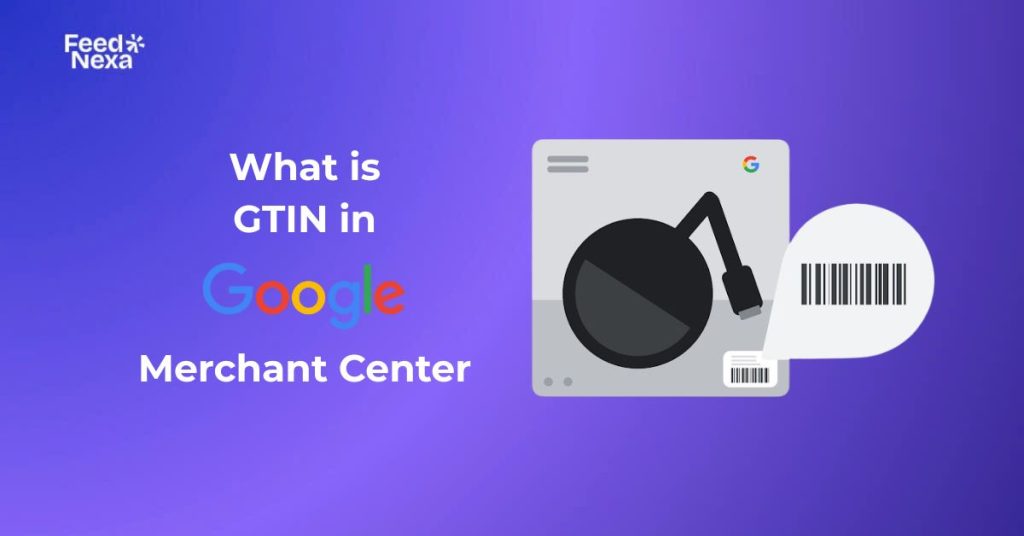
If you want your products to show up properly in Google Shopping, you’ll need to get one thing right: the GTIN in Google Merchant Center. GTINs help Google understand exactly what you’re selling so your listings can appear in the right searches, with better visibility and higher approval rates.
In this guide, we’ll walk you through everything you need to know, from what GTIN is, how to find it, to common errors and how to fix them. Let’s make sure your products never get disapproved again!
What is GTIN in Google Merchant Center?
To succeed in Google Shopping, you must speak Google’s language, GTINs. To put it simply, every product that is sold in the retail world carries something called a GTIN, or Global Trade Item Number.
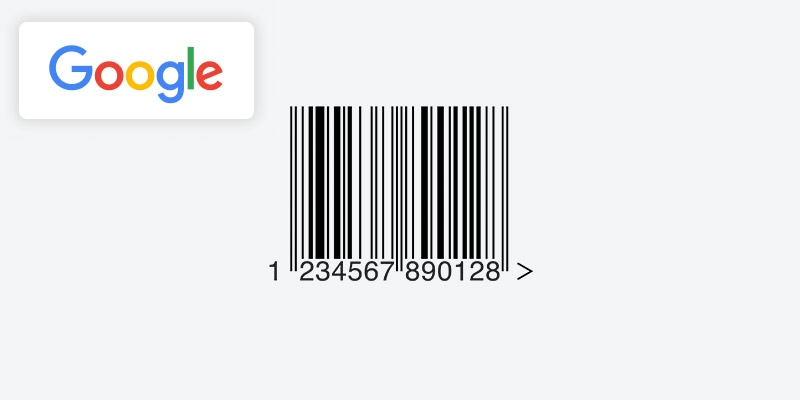
Google Merchant Center uses GTINs to match your products to its catalog. This improves relevance, brings more visibility in Shopping results, and lessens the chance of disapproval under “missing identifiers”. In other words, you have to supply a GTIN if it already exists for the product (UPC, EAN, etc.) on the system.
Why GTIN matters in Google Merchant Center
If GTINs are missed, products may not be properly matched to listings, which leads to product ranking and display modifications on Google Shopping. So, it’s critical to implement it correctly.
1. Increase product visibility
Using GTINs ensures that Google’s algorithm correctly recognizes your products. This helps your listings match more precisely with user search intent and popular queries.
This allows them to roll up to some of the highest slots across Google Shopping and Ads. Forged from such sheer competition, even the slightest visibility can turn around traffic and sales for any brand.
2. Boost ad performance and ROI
Google relies on GTINs to identify the exact product you’re advertising. This makes for well-matched ads, thus raising relevance and Quality Score.
With ads performing better, they get higher clicks (CTR) and conversion rates without having to increase spending. That means stronger returns and smarter use of your ad budget.
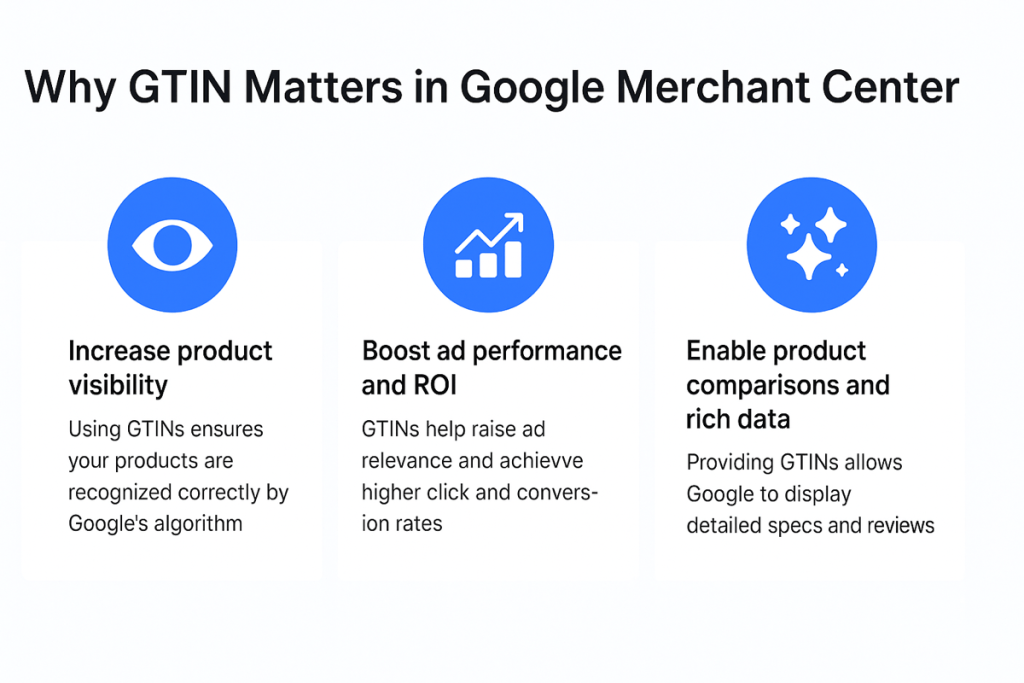
3. Enable product comparisons and rich data
When GTINs are provided, Google can pull in detailed specs, reviews, and comparisons from other listings selling the same product. That levels the playing field and makes your listing more informative.
The buyers find themselves being served with standardized data, which greatly enhances their confidence and engagement with the seller’s data. No GTIN could mean the listing may seem incomplete, or miss out on enhanced features, like star rating or product badges.
How to Find Your Product’s GTIN for Google Merchant Center
The correct GTIN ensures the approval of your listings with minimum delay or unwarranted rejections. You can obtain the GTIN for your products in the following ways:
Option 1: Check your product packaging or barcode label
Look at the physical product or its packaging for a barcode. Usually, the number below the barcode represents the GTIN, which can consist of 8, 12, 13, or 14 digits, depending on the region and type of product.

Option 2: Look it up in your manufacturer’s documentation
With branded products, you may find in the manufacturer or supplier documentation, whether it’s a product sheet or an invoice, the GTIN should be provided there.
How to Add GTIN in Google Merchant Center
To avoid disapprovals and improve product visibility, it’s important to submit accurate GTINs in your product feed. Here are three reliable methods to do it, depending on your store setup.
1. Manually add GTIN to individual products
If you’re only managing a few items, the quickest method is to edit GTINs directly in Merchant Center.
Step 1: Log in to your Google Merchant Center account.
Step 2: Navigate to Products > All Products and select the product you want to edit.
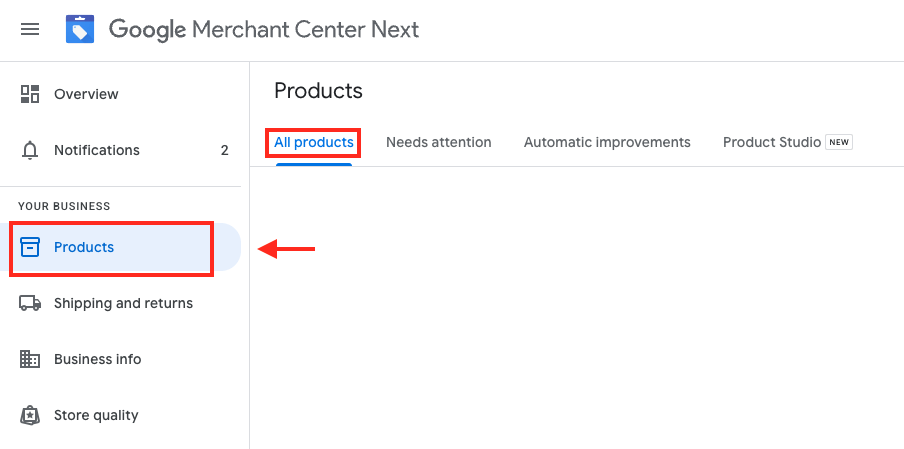
Step 3: Scroll down to the Product identifiers section.
Step 4: Enter the correct GTIN based on the packaging or manufacturer source.

Step 5: Click Save. Google will re-crawl the product and reflect the updates shortly.
💡 Tip: If no GTIN is available, you must provide both the Brand and MPN (Manufacturer Part Number) to meet Google’s requirements.
2. Upload GTINs in bulk using Google Sheets
Handling a large inventory? A spreadsheet is the most efficient solution.
Step 1: In Merchant Center, go to Products > Feeds and select your existing feed (or create a new one using Google Sheets).
Step 2: In your sheet, ensure there is a column named GTIN.
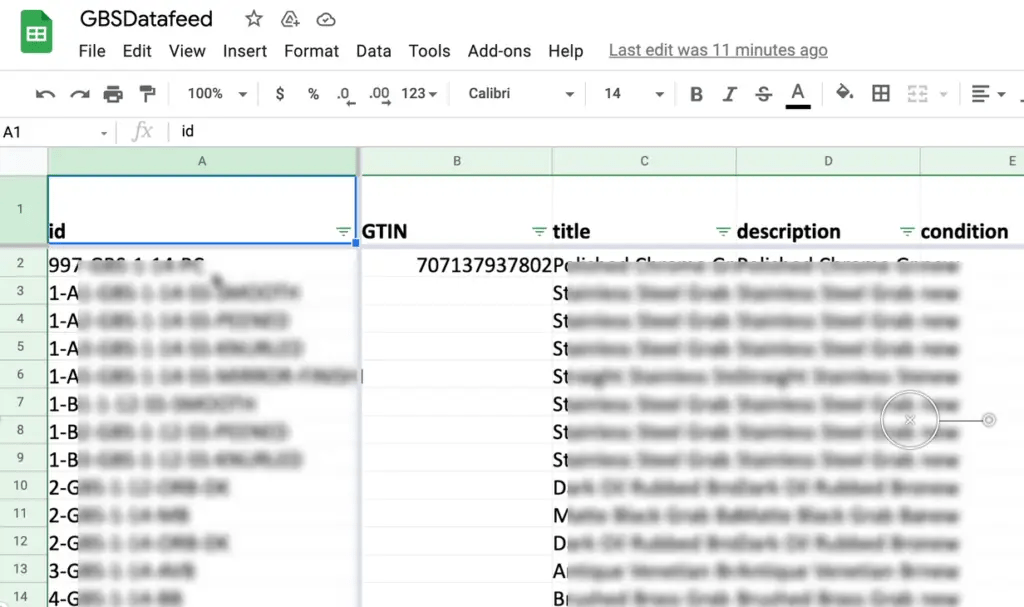
Step 3: Enter the corresponding GTINs for each product.
Step 4: Save your changes and allow Google to process the new data on the next scheduled fetch.
⚠️ Tip: Make sure GTINs are valid and match the official global database (GS1 or manufacturer sources). Invalid entries may trigger disapprovals.
3. Automate GTIN submission using Feednexa
If you’re running a Shopify store with a large product catalog, Feednexa is a powerful app that simplifies the entire GTIN process.
- Auto-sync product data: Feednexa pulls GTINs directly from your Shopify listings and maps them to the correct fields in Google Merchant Center.
- Real-time validation: The app checks your GTINs against formatting and submission rules to reduce errors and disapprovals.
- Hands-off updates: Any changes you make in Shopify will automatically be reflected in the Merchant Center without manual re-uploading.
Feednexa is the app for merchants who want to keep compliant while remaining competitive and who want to do so without staying awake half the night negotiating spreadsheets. You can try out the app on the Shopify App Store to see it in action.

We’ve compared the three best ways to add GTINs to Google Merchant Center, depending on your store setup and product count.
| Method | Difficulty | Key Benefit | Best for |
|---|---|---|---|
| Manual entry | 🟢 Easy | Quick for a few products, easy to apply directly in GMC | Small catalogs |
| Google Sheets | 🟡 Intermediate | Update GTINs in bulk without editing products one by one | Growing catalogs |
| Feednexa automation | 🔵 Easiest | ✅ Auto-sync GTINs from Shopify✅ Real-time validation✅ No manual uploads or spreadsheets | Shopify stores with 50+ SKUs |
Common GTIN Errors and How to Fix Them
Even with a clean product feed, GTIN issues can still show up and impact your visibility on Google Shopping. Below are the most common errors and how to fix them effectively.
Missing GTIN warning
Issue: Google flags your product with “Missing GTIN” if the GTIN field is left empty or the identifier_exists attribute is set to “yes” without a value. This limits visibility and approval.
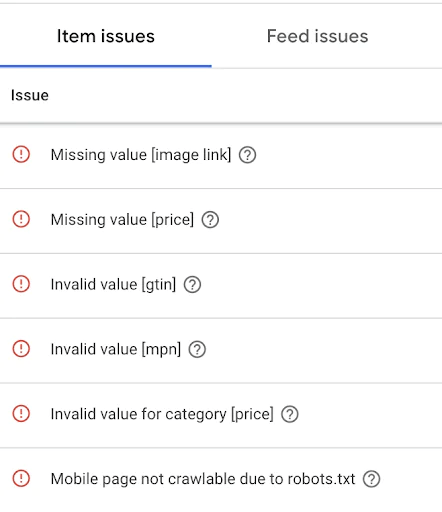
How to fix: Make sure every eligible product has a valid GTIN. Double-check your product catalog or Shopify backend. If you’re using Feednexa, enable auto-sync to pull GTINs into the correct fields and eliminate manual gaps.
Invalid GTIN or incorrect formatting
Issue: GTINs with incorrect lengths (not 8, 12, 13, or 14 digits), alphabetic characters, or extra symbols will be rejected. Common causes include copy-paste errors or wrong data entries.
How to fix: Remove all non-numeric characters and ensure the GTIN is the correct length. You can also run validation in bulk using tools like Feednexa, which flags formatting errors during the feed sync.
Duplicate GTINs or mismatches
Issue: When the same GTIN is assigned to multiple products with different attributes (like brand, title, or variant), Google may disapprove them due to inconsistent data.
How to fix: Confirm that each GTIN matches the product it represents exactly. For variants or bundles, use unique GTINs. Feednexa’s real-time sync can help ensure correct product-to-GTIN mapping across your catalog.
Learn More: How to Solve Limited Performance Due to Missing Value GTIN
Bonus Tips to Optimize Google Shopping Listings with GTIN
Once you have fixed the errors and submitted the GTINs correctly, a few additional strategies can be deployed to fortify your product listings. These activities aid your advertisement placements and, with time, improve visibility and, subsequently, conversion.
Now, let’s look into a few best practices that will leverage your GTIN data to benefit your store.
Combine GTIN with brand and MPN
GTIN alone isn’t always enough. Google recommends pairing it with the product’s Brand and Manufacturer Part Number (MPN) to create a stronger product identity.
This triple-match approach helps Google better understand what you’re selling, which leads to better indexing and stronger placement in Shopping results.
Keep GTINs updated when suppliers change
Switching to a new supplier or brand? Double-check that the product’s GTIN hasn’t changed. Mismatched data can trigger disapprovals or reduce performance.
Regularly syncing your product feed with reliable data sources prevents surprises and ensures consistency across your entire catalog.
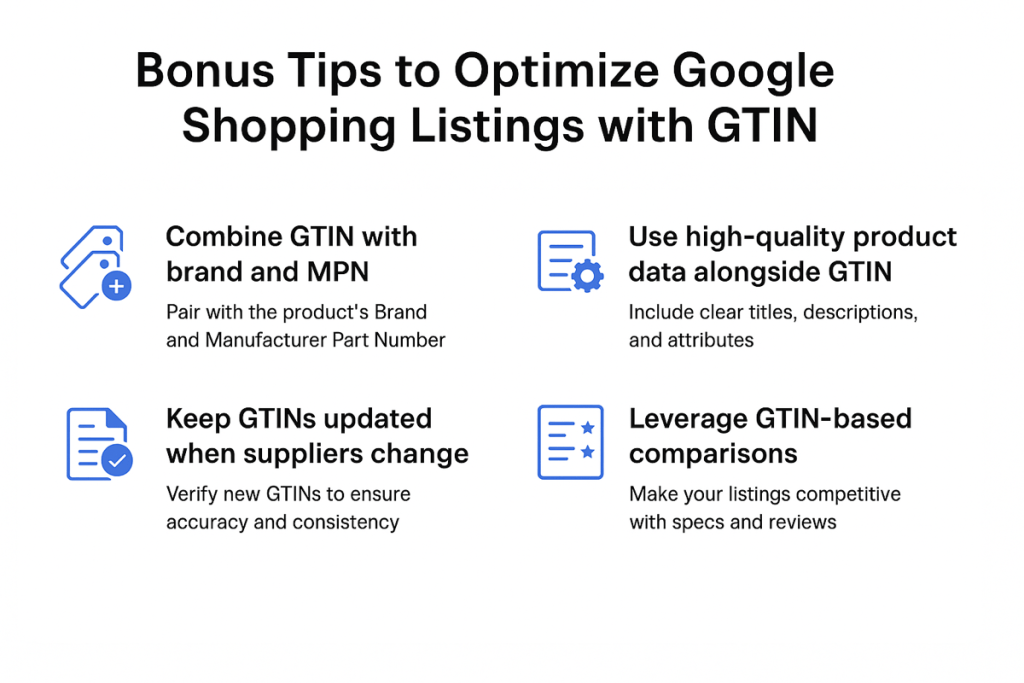
Use high-quality product data alongside GTIN
A valid GTIN is the foundation, but rich product content is what brings it to life. Include clear titles, detailed descriptions, and accurate attributes.
Together, this data helps Google understand and rank your listings more effectively, especially when paired with clean, verified GTINs.
Leverage GTIN-based comparisons
When your product shares a GTIN with other sellers, Google can display product comparison panels that showcase specs, reviews, and prices.
This makes your listing more competitive. Offering better descriptions or pricing can help you differentiate yourself, even when selling the exact item.
Conclusion
Using exact GTINs in your Google Merchant Center product data is among the technical requirements that can drive better visibility for the products, better ad performance, and more trust. A clean, compliant product GTIN setup ensures that your listings get seen, accepted, and clicked on by the right shoppers.
If you sell through Shopify, tools such as Feednexa can take all the manual work away from syncing GTINs into your Merchant Center feed automatically. This means that you can save time, make fewer mistakes, and grow more quickly with better data.
Get started with product listing optimization today, and your conversion rates will thank you!